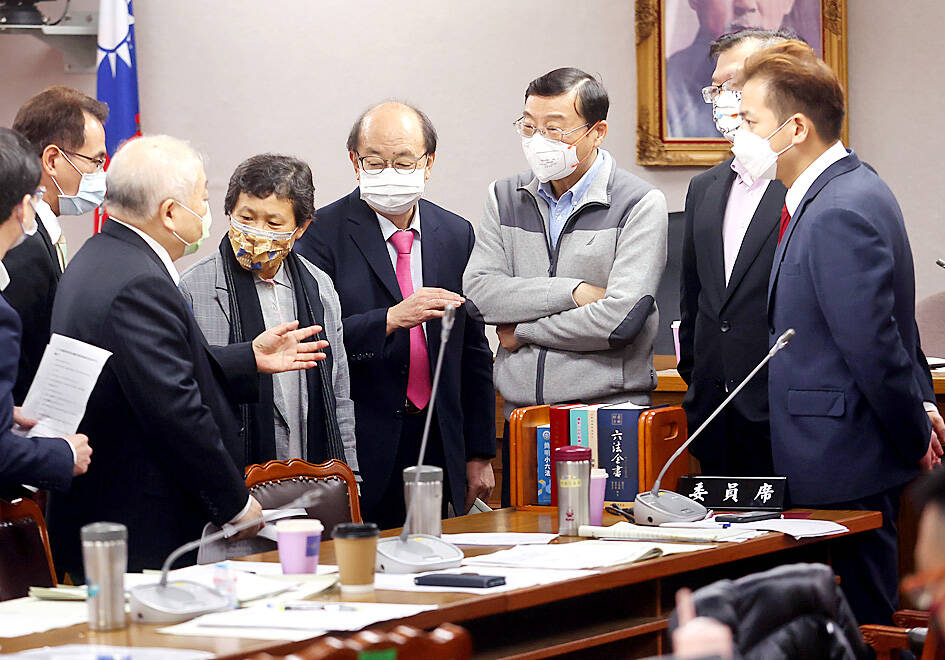The difference between the government’s GDP projection and the nation’s real economic performance accounts for a tax surplus from last year, finance officials told lawmakers yesterday.
The comments came after people questioned the legitimacy of tax surpluses from the past two years, as the government has said it would use part of a NT$450 billion (US$14.74 billion) tax surplus to distribute cash payments of NT$6,000 next month.
Directorate-General of Budget, Accounting and Statistics (DGBAS) Minister Chu Tzer-ming (朱澤民) said that the agency in August 2020 forecast GDP growth of 3.92 percent for 2021, but the real growth approached 6.5 percent, thanks to strong demand for electronic devices used in remote work and education.

Photo: CNA
Manufacturing sectors and individuals gained much higher incomes than expected, which inflated state coffers, Chu said.
DGBAS officials normally prepare fiscal budgets up to two years in advance based on data from recent years, and were therefore unable to account for the economic effects of the COVID-19 pandemic and the Russian invasion of Ukraine.
In 2021, securities and property transfers also outperformed government predictions by a wide margin and boosted related taxes, Chu said.
Major firms posted robust earnings in the first half of last year, but saw acute inventory corrections in the final quarter, as drastic interest rate hikes by global central banks hurt demand for goods and services, he said.
This resulted in another year of massive tax surpluses, helped by a quick recovery in private consumption after COVID-19 restrictions were relaxed and the nation reopened its borders, the DGBAS said.
When factoring in COVID-19 spending, the government incurred a small deficit last year, Chu said.
Acting Minister of Finance Frank Juan (阮清華) said the two-year time lag plays an important part in creating tax surpluses or shortfalls.
GDP growth over the past two years deviated from long-term averages, making budget projections difficult, Juan said.
Former minister of finance Su Jain-rong (蘇建榮) told a tax forum yesterday that it is not accurate to say tax surpluses are policy mistakes, as some officials have said.
Tax surpluses stem from the nation’s stronger-than-expected economic performance, said Su, who has resumed his position as a professor of finance at National Taipei University.
Su said he had reservations about the cash distribution plan, saying that the government should first seek to pay off its debt and enhance its financial resilience to avoid fiscal deficits or financial shocks.
The government has accumulated huge debts, which could become burdens on future generations, Su said.

MULTIFACETED: A task force has analyzed possible scenarios and created responses to assist domestic industries in dealing with US tariffs, the economics minister said The Executive Yuan is tomorrow to announce countermeasures to US President Donald Trump’s planned reciprocal tariffs, although the details of the plan would not be made public until Monday next week, Minister of Economic Affairs J.W. Kuo (郭智輝) said yesterday. The Cabinet established an economic and trade task force in November last year to deal with US trade and tariff related issues, Kuo told reporters outside the legislature in Taipei. The task force has been analyzing and evaluating all kinds of scenarios to identify suitable responses and determine how best to assist domestic industries in managing the effects of Trump’s tariffs, he

TIGHT-LIPPED: UMC said it had no merger plans at the moment, after Nikkei Asia reported that the firm and GlobalFoundries were considering restarting merger talks United Microelectronics Corp (UMC, 聯電), the world’s No. 4 contract chipmaker, yesterday launched a new US$5 billion 12-inch chip factory in Singapore as part of its latest effort to diversify its manufacturing footprint amid growing geopolitical risks. The new factory, adjacent to UMC’s existing Singapore fab in the Pasir Res Wafer Fab Park, is scheduled to enter volume production next year, utilizing mature 22-nanometer and 28-nanometer process technologies, UMC said in a statement. The company plans to invest US$5 billion during the first phase of the new fab, which would have an installed capacity of 30,000 12-inch wafers per month, it said. The

Taiwan’s official purchasing managers’ index (PMI) last month rose 0.2 percentage points to 54.2, in a second consecutive month of expansion, thanks to front-loading demand intended to avoid potential US tariff hikes, the Chung-Hua Institution for Economic Research (CIER, 中華經濟研究院) said yesterday. While short-term demand appeared robust, uncertainties rose due to US President Donald Trump’s unpredictable trade policy, CIER president Lien Hsien-ming (連賢明) told a news conference in Taipei. Taiwan’s economy this year would be characterized by high-level fluctuations and the volatility would be wilder than most expect, Lien said Demand for electronics, particularly semiconductors, continues to benefit from US technology giants’ effort

‘SWASTICAR’: Tesla CEO Elon Musk’s close association with Donald Trump has prompted opponents to brand him a ‘Nazi’ and resulted in a dramatic drop in sales Demonstrators descended on Tesla Inc dealerships across the US, and in Europe and Canada on Saturday to protest company chief Elon Musk, who has amassed extraordinary power as a top adviser to US President Donald Trump. Waving signs with messages such as “Musk is stealing our money” and “Reclaim our country,” the protests largely took place peacefully following fiery episodes of vandalism on Tesla vehicles, dealerships and other facilities in recent weeks that US officials have denounced as terrorism. Hundreds rallied on Saturday outside the Tesla dealership in Manhattan. Some blasted Musk, the world’s richest man, while others demanded the shuttering of his